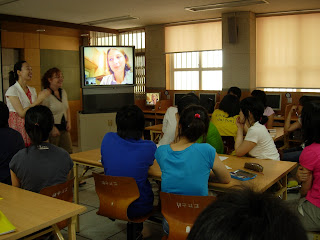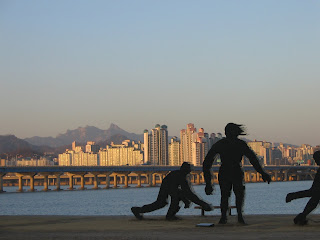 Dear Friends and Family,
Dear Friends and Family, My friend Peter married today. His wedding was lovely to witness... different than other weddings that I have so far been to in Korea. In fact, other weddings that I've attended here have been... confusing. Please allow me to attempt to explain.
I received my first Korean wedding invite last winter, out of the blue and via cell phone. My friend Cathy called to ask, “Do you want to go the Vice Principal’s daughter’s wedding? Tomorrow?”
Instantly I felt very uncomfortable. “But I haven’t received an invitation.” I protested, picturing the very Western, very necessary paper invitation.
Cathy laughed and merrily told me, “That’s not how it works here – just come.” she said.
As if I could say no. “What about a gift?” I asked.
“30,000 Won is what we usually give. I’ll bring you an envelope.” She replied.
Hmm. Anyway, so that is how I learned that in
A delicate snow was falling the next day as us single women teachers, dressed in shiny, ruffled finery, arrived at the appointed “Wedding Hall,” a froofy building specially made for weekend weddings – this particular hall had long faux Greek columns and a large advertisement of a beautiful Korean woman, replete in caked make-up and an amazing concoction of a white dress. We took an elevator to the wedding level and walked into a crowded reception hall, where our Vice Principal stood at random, looking very dignified in his tie that coordinated with his wife’s traditional hanbok while other guests milled around. My friends immediately approached and bowed to him – as did I – but I threw in a hand shake and warm congrats. We then handed our traditional Chinese character wedding envelopes with cash to the appropriate person and received, in return, a dining ticket.
Next we proceeded into a large room with dusty chandeliers and faux plasterwork reminiscent of a hotel conference room. There was a red carpet aisle framed by wilting silk flowers, individual faux Rococo chairs had been set up for guests, and an altar was alight with electric candles and more silk flowers. The guests were not quiet nor settled when the ceremony began with Mendelson’s wedding march. Two women in red faux military uniforms strode up the aisle to form a fake sword arch for the bride to advance through. The groom appeared and next down the aisle came the bride, tightly coiffed in a rented western-style wedding dress, while the guests barely noticed and continued to chat away. A suit-clad officiate talked and talked for what felt like forever while the bride and groom said nothing. The ceremony ended with a flourish: the uniformed ladies raised fake trumpets, pushed some button and out came a bunch of shiny streamers and strange music. The bride and groom turned to the still-chatting audience, for the photographer’s sake, I guessed, and then together walked down the aisle – both taut with nervousness.
We guests then departed from the ceremony hall to the downstairs buffet room. We presented tickets at the entrance, grabbed plates and subsequently enjoyed an all you can eat traditional Korean food buffet with rice, soap, raw fish, chicken, noodles, different types of kimchi, pork and other yummy edibles. And then we left. And that was it.
To say that I was startled and puzzled by this wedding is to say the least. The wedding appeared Western: the clothing, the music, the swords, the room. But the behavior wasn’t western: tangible joy wasn't present, our weddings are planned for months in advance, our weddings are “individualized” by the bride, and we guests daren’t talk through a wedding. And my consternation about the Korean wedding only deepened when I was told that the ceremony I witnessed wasn’t the legal wedding. Huh? Why go through the elaborate charade… dress… music? Where was the meaning behind a wedding ceremony? Was the ceremony for appearances only?
Well, yes, appearances are a key consideration. Because Korean brides and grooms actually go through two, perhaps three ceremonies. The first ceremony is the frothy western-looking one; the ceremony’s basic intent is to gather all the relatives, friends and acquaintances, get them to give gifts of money, and give them something to talk about. After that first ceremony, the bride, groom, and their immediate family change into traditional Korean hanbok and a second ceremony takes place, this time a Confucian ceremony where I’d guess that a great deal of bowing interspersed with a bit of eating and drinking takes place. Frankly, I’m still unclear about when Koreans legally marry – that could be another ceremony because I’ve been told that couples legally marry after they return from their honeymoon – which can present a problem if the bride or groom perishes during the honeymoon. I haven’t verified that tidbit but if it is true, I’m uncharacteristically happy to declare that portion of the process utterly illogical.
Although I must say that I found the whole kit and caboodle puzzling. So, like an annoying five year-old, I kept asking why questions. And at some point, I formed the understanding that one hundred years ago,
Therefore, counter-intuitively, my friend’s traditional wedding today made much more sense to me than the “modern” weddings I’ve been to. Held at an open air, rather beautiful Confucian Academy that is actually a stop on the Daegu City Tour bus (if curious, refer to 10/11/06), we found the groom was standing near the entrance in a flowered black silk hanbok set, complete with hat and shoes. He greeted guests and stoically endured the indignation of lots of stares punctuated by lots photographs. While the bride was also being photographed, tucked away in her own little side room, clad in an amazing pink hanbok, a beaded headdress, and with a rounded red sticker on each cheek.
Eventually the bride and groom were escorted to platforms in which four strong men would carry them to the ceremony. The groom went first, seated in a wooden chair covered with a silk cushion, that reminded me of the open thrones of old kings of
The officiate, clad in a traditional white hanbok and a tall black hat, had firm possession of the microphone and began to speak in formal Korean. The bride and groom, once arranged on individual sides of the altar, began with hand washing from brass bowls, included bowing, eating a food that resembled the Korean green onion pancakes (pa jon) with chopsticks, and some alcohol drinking. The officiate carried on for a while before the bride and groom finally retreated back down the aisle together to the applause of their guests. We at the back also clapped and as the groom passed he directed an aside of “I have no clue what just happened!” at me. I laughed and followed the two so I could snap a picture of them together. We stood in the sunshine for sometime while more photographs were taken and even we friends were included in the photographs as the groom’s family could not come from
Afterwards, the bride and groom departed to peel away a few layers from their hanboks while we guests went to enjoy a traditional lunch of soup, rice, kimchi, rice cakes, and numerous other side dishes. After we had consumed our fill, we bid the bride and groom farewell… and that was that. Their wedding was lovely. And satisfying for me as a Western witness because of the palpable love that I saw between the couple – and because of the ceremony’s perfectly comprehendible Confucian Koreanness.
Many happy returns, Peter and Celine!
Love,
Laura
PS: Some interesting Korean wedding tidbits:
- Several times now I’ve heard the criticism that modern Korean weddings lack sentiment and are actually carried through simply to make money for the bride and groom. My experience seems to confirm this; but I think I prefer the supposed Korean profit-making lack of sentiment to the Western sentiment demonstrated by a couple getting into extreme wedding debt.
- The wooden duck, carried behind the groom at Peter’s wedding, symbolizes a long and happy marriage. While the cranes on the bride’s palanquin are a symbol of long life.
- Apparently in old-style Korean weddings, the bride and groom would retire to one of the rooms of the house specially decorated for the occasion. Outside the room, relatives would use their fingers to poke small holes in the rice paper covering the windows of the room so they could watch what happened inside. Ostensibly, they did this to ensure that the bride did not run away in frustration as the grooms were often much younger than the brides and they often did not know what to do.But Koreans, as a culture, are what we Westerners would consider more than a mite nosy when it comes to “personal business” – and these actions sound like classic nosiness to me!!!




the family portrait session....








































